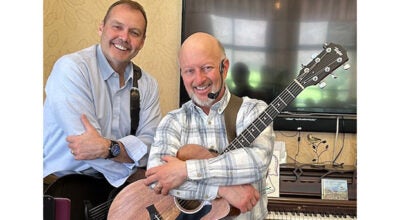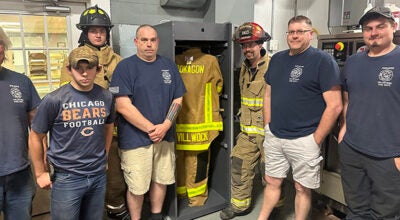Nodes the seat of 360-degree learning
Published 7:54 am Wednesday, May 11, 2011

It takes no time or noise to divide a 30-student class into small cooperative learning pods. (The Daily News/John Eby)
Thirty Steelcase “Node” desks Union High School has been taking for a test spin the past two weeks earn a passing grade from Mike Williams’ social studies students.
The desks are ergonomically designed, move on wheels to impart learning in new ways and are emblematic of the innovative avenues Superintendent Dr. Mark Daniel, Board of Education President Larry Seurynck and other school officials have been exploring since the Disney Way initiative at the beginning of March.
“It depends on the activity we’re doing,” Williams said Tuesday, “but they can just spin and be with a partner immediately” for what educators like to call cooperative learning.
“Three hundred and 60-degree learning,” Tony Brooks dubbed it.
Last week Williams’ American history students “questioned each other” in a “group test.”
“It makes things a lot quicker, easier and more efficient,” Williams added.
While they look somewhat like amusement park bumper cars that students would fidget and twirl in endlessly, students said that’s not the case.
They appreciate not banging their shins every time they leave their desk, which are comfortable and reminiscent of college lecture halls with their flaplike writing surfaces.
But thanks to the wheels on carpet, they pivot soundlessly into place and can immediately form a four-station conference table without sacrificing any time shoving furniture around to reconfigure the room.
“As a teacher, it allows me to do a lot more,” Williams said. “Time efficiency is important with the amount of kids and activities. We lined them up, one here and one there. Each asked the other questions. If they got the question wrong, they had to roll over to the other side of the classroom. Now they’re on that team. They could go back and forth. Whoever answered the most questions won.”
“Steelcase has a whole line of furniture and classroom designs for new tech high schools,” Principal Paul Hartsig said.
A cross-section of Dowagiac has examined such learning innovations on field trips.
Where traditional teaching relied on a sage on the stage who recited data students dutifully jotted down in notes, the voluminous amount of information a click away on the Internet reordered priorities to lifelong learning and how to find answers rather than memorizing dates. Teachers become facilitators.
“They actually save a lot of space compared to the desks,” Williams indicates.
While durability would seem to be a concern with so many wheels on so many chairs, “They’ve been tested for heavy use, heavy stress, and they don’t break,” Hartsig said.
Twenty-nine of the Nodes are gray.
The 30th happens to be light green.
They have little baskets underneath to stow books and personal belongings.
Berrien Springs tried out the furniture prior to Dowagiac.
Next week the demonstration Nodes will be on loan to another school somewhere else.
“They’re really good for the freshmen,” Williams said. “Today we’re talking about civil law. They have to come up with their own case with a partner. They can only say what they’re going to sue each other for. One person is a plaintiff, the other a defendant. Then they separate, go write their story, then they have to get with someone else and have them read their story.”
“it’s quick,” he punctuates his sentence by snapping his fingers. “They go from one to another continuously all around the classroom, very quickly and efficiently. Before, I wouldn’t have done that many times” because of the disruption risk movement equated.
“It doesn’t take forever to move desks around, so it’s enjoyable,” he said. “It’s smooth. The only disadvantage the kids see is it has a small desktop.”






